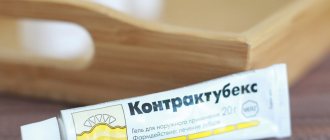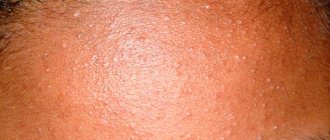Mirvaso Derm 0.5% 10 g gel for external use
Description
Opaque gel from white to light yellow.
pharmachologic effect
Facial erythema with rosacea is treated with a selective alpha2-adrenergic agonist. Brimonidine is a highly selective alpha2-adrenergic receptor agonist: its affinity for alpha2-adrenergic receptors is 1000 times greater than its affinity for alpha1-adrenergic receptors. Application of a highly selective alpha2-adrenergic receptor agonist to the facial skin leads to a decrease in erythema due to direct vasoconstriction of skin vessels.
Indications
Treatment of facial erythema with rosacea.
Contraindications
- Hypersensitivity to brimonidine or to any of the excipients; - children under 18 years of age (the safety and effectiveness of the drug for this age category has not been established); - simultaneous use with monoamine oxidase inhibitors (MAO) (for example, selegiline or moclobemide), and tricyclic (imipramine) and tetracyclic (maprotiline, mianserin and mirtazapine) antidepressants that affect noradrenergic transmission. With caution: - Pregnancy; - dysfunction of the liver and kidneys.
Recommendations for use
For external use only. A small amount of gel is applied in a thin layer to the skin of each of the 5 areas of the face (forehead, chin, nose, cheeks) once a day if erythema is present. The maximum recommended daily dose of the drug, divided into 5 parts according to the areas of application, is 1 g. When applied to the skin, Mirvaso® Derm gel should be distributed evenly in a thin layer over the face, avoiding contact of the drug with the eyes, eyelids, lips, mouth and mucous membranes the membrane of the nose. The gel should only be applied to the face.
special instructions
Mirvaso® Derm should not be applied to irritated skin or open wounds or the area around the eyes. In case of severe irritation or allergy, treatment with the drug must be interrupted. After using the drug, be sure to wash your hands. The drug Mirvaso® Derm can be used in conjunction with other medications used to treat the inflammatory elements of rosacea. They can be applied to the skin only after Mirvaso® Derm has dried, and not simultaneously with it. After Mirvaso® Derm has been applied and dried, cosmetics can be used. Erythema and hyperemia The effect of Mirvaso® Derm begins to weaken a few hours after application. In some patients, resumption of erythema and transient hyperemia in a more severe form than was observed before treatment has been described. Most cases of erythema were observed during the first 2 weeks after the start of treatment. Transient hyperemia was observed in some patients. The time of onset of hyperemia after applying the gel varied from 30 minutes to several hours. In most cases, erythema and hyperemia resolved after discontinuation of the drug. If erythema worsens, use of the drug should be discontinued. Symptomatic measures such as cooling, nonsteroidal anti-inflammatory drugs, and antihistamines may relieve symptoms. After resumption of use of the drug Mirvaso® Derm, relapses of exacerbations of erythema and hyperemia were observed. However, if necessary, treatment can be resumed after the skin barrier function has been restored, starting with a trial application of the drug to a small area of the face at least 1 day before completely resuming treatment of the entire facial skin. The recommended dose and frequency of application should be strictly observed: once a day, in a very thin layer. Increases in the maximum daily dose and/or frequency of use should be avoided as the safety of higher daily doses or repeated daily use has not been established. Concomitant use with systemic alpha-adrenergic receptor agonists may increase the side effects of this class of drugs in patients with: - severe or uncontrolled or unstable cardiovascular diseases; - depression, cerebral or coronary circulatory insufficiency, Raynaud's disease, orthostatic hypotension, thromboangiitis obliterans, scleroderma or Sjögren's syndrome. Mirvaso® Derm contains methyl parahydroxybenzoate, which can cause allergic reactions (possibly of a delayed type), as well as propylene glycol, which can lead to skin irritation. Impact on the ability to drive vehicles. Wed and fur.: The drug does not affect or slightly affects the ability to drive vehicles or engage in other potentially hazardous activities that require increased concentration and speed of psychomotor reactions.
Compound
1 g of gel contains: Active ingredient: Brimonidine tartrate - 5.0 mg. Excipients: carbomer - 12.5 mg, methyl parahydroxybenzoate - 1.0 mg, phenoxyethanol - 4.0 mg, glycerol - 55.0 mg, titanium dioxide - 0.625 mg, propylene glycol - 55.0 mg, sodium hydroxide - up to pH 6 ,0, purified water - up to 1000 mg.
Side effects
During clinical studies, the most frequently observed (1.2-3.3%) adverse reactions included redness, itching, flushing and burning sensation of the skin. As a rule, these reactions were mild or moderate in severity and did not lead to discontinuation of treatment. Cases of exacerbation of rosacea symptoms have been reported in patients treated with Mirvaso® Derm. Considering the data from all clinical studies conducted, cases of exacerbation of symptoms were noted in 16% of patients. There were no significant differences in the safety profile between elderly patients and patients aged 18 to 65 years. During the post-registration period, frequent cases of increased redness, flushing, burning sensation of the skin and blanching of the skin at the site of application were noted. Adverse reactions obtained during clinical trials (see Table 1) are classified by organ system and frequency of development. Determination of the categories of frequency of adverse reactions: very often (>1/10), often (>1/100 to <1/10), uncommon (>1/1000 to <1/100), rarely (>1/10,000 to < 1/1000), very rare (<1/10,000), frequency unknown (cannot be estimated based on available data).
Drug interactions
No studies have been conducted to study the interactions of the drug with other drugs. Brimonidine is contraindicated in patients taking monoamine oxidase inhibitors (MAOIs) and in patients taking tricyclic and tetracyclic antidepressants that affect noradrenergic transmission. The possibility of additive or potentiating effects should be considered when brimonidine is used concomitantly with substances that depress the central nervous system (alcohol, barbiturates, opiates, sedatives or anesthetics). There are no data on the effect of brimonidine on circulating catecholamine levels. However, caution is recommended in patients receiving drugs that can affect the metabolism of amines and increase their concentration in the blood, such as chlorpromazine, methylphenidate, reserpine. Caution is recommended when concomitantly using brimonidine or changing its dose in the treatment of ophthalmic diseases. Caution is recommended when initiating treatment or changing the dose of co-prescribed systemic drugs (regardless of their dosage form) that may interact with or affect the activity of alpha-adrenergic receptor agonists, i.e., are adrenergic receptor agonists or antagonists (e.g. isoprenaline, prazosin). In some patients, brimonidine may cause a clinically insignificant decrease in blood pressure, so caution should be exercised when using drugs such as antihypertensives and/or cardiac glycosides concomitantly with brimonidine.
Overdose
There is no information on brimonidine overdose when used externally in adult patients. In case of accidental use of the drug orally, overdose of alpha2-receptor agonists may occur such as hypotension, weakness, vomiting, drowsiness, lethargy, bradycardia, arrhythmia, miosis, apnea, hypotension, hypothermia, respiratory depression and convulsions. During the clinical study, there were 2 cases of serious adverse events caused by accidental ingestion of Mirvaso® Derm by young children. The symptoms observed in the children were consistent with known symptoms of alpha2-agonist overdose in young children and completely resolved within 24 hours. Treatment of overdose when taking the drug orally includes supportive and symptomatic therapy, it is necessary to maintain airway patency.
Storage conditions
At a temperature not exceeding 30 °C. Do not freeze. Keep out of the reach of children.
Best before date
2 years. After the first opening, store the drug for no more than 6 months, at a temperature not exceeding 25 ° C. Do not use after expiration date.
Mirvaso® Derm
Mirvaso® Derm should not be applied to irritated skin (including after laser therapy) or open wounds, or the area around the eyes. In case of severe irritation or allergy, treatment with the drug must be interrupted.
The drug Mirvaso® Derm can be used in conjunction with other products for the treatment of inflammatory elements in rosacea, and cosmetics. They can be applied to the skin only after Mirvaso® Derm has dried, and not immediately before it.
Erythema and hot flashes
The effect of Mirvaso® Derm begins to weaken a few hours after application. In some patients, a return of erythema and hot flashes that was more severe than that observed before treatment has been described. Most of these cases occurred within the first 2 weeks after the start of treatment.
Some patients receiving Mirvaso® Derm therapy experienced hot flashes. The time at which their development began varied from 30 minutes to several hours after application of the gel.
In most cases, erythema and hot flashes disappeared after discontinuation of the drug.
If the erythema worsens, the use of Mirvaso® Derm should be suspended. Symptomatic measures such as cold packs, non-steroidal anti-inflammatory drugs and antihistamines may relieve symptoms.
After the resumption of use of the drug Mirvaso® Derm, cases of exacerbation of erythema and hot flashes in an aggravated form were observed. After a temporary break in treatment, resumption of use of Mirvaso® Derm should begin with a trial application of the drug to a small area of facial skin at least 1 day before switching to treatment with the drug when applied to the entire surface of the facial skin.
The recommended dose and frequency of application should be strictly observed: once a day, in a very thin layer.
Increases in the maximum daily dose and/or frequency of use should be avoided as the safety of higher daily doses or repeated daily use has not been established.
Concomitant use with systemic alpha-adrenergic receptor agonists may increase the side effects of this class of drugs in patients with:
- severe or uncontrolled or unstable cardiovascular diseases;
- depression, cerebral or coronary circulatory insufficiency, Raynaud's disease, orthostatic hypotension, thromboangiitis obliterans, scleroderma or Sjögren's syndrome.
Mirvaso® Derm contains methyl parahydroxybenzoate, which can cause allergic reactions (possibly of a delayed type), as well as propylene glycol, which can lead to skin irritation.




